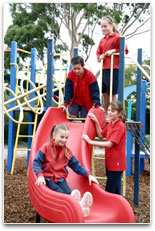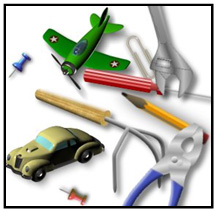This focus idea is explored through:
Contrasting student and scientific views
Student everyday experiences
 The word ‘force’ has many meanings in the everyday lives of students. These common meanings substantially shape the understandings that students develop of the word ‘force’.
The word ‘force’ has many meanings in the everyday lives of students. These common meanings substantially shape the understandings that students develop of the word ‘force’.
For example:
- She is forcing the pen to move.
- The police force.
- May the Force be with you.
There is a view widely held by students of a force as having some material existence and being somehow embedded in moving things. A moving object is thought to ‘contain’ or ‘have’ force. Some students think such a force keeps objects moving; and that objects slow down and stop because this force is gradually used up.
Research:
Osborne & Freyberg (1985)
Students also believe that something that can’t be observed or felt by humans (or animals) doesn’t exist: for example, they might believe that, “There is no force on the car [being pushed by a man] because it can’t feel anything, but there is a force on the man because he has to push it.”
Research:
Osborne (1980)
Scientific view
In science, the word ‘force’ has a precise meaning. At this level, it is completely appropriate to describe a force as a push or a pull.
A force is not something that an object contains or ‘has in it’. A force is exerted
on one object
by another.
The idea of a force is not limited to living things or non-living things. All objects (living and non-living) can apply a force on or to another object; also all objects (living and non living) can be affected by forces.
These ideas are also developed in the focus idea
Pushes and pulls.
Critical teaching ideas
- In science, we call a ‘push’ or a ‘pull’ a ‘force’.
- When we talk about forces we consider the forces acting on an object
by another object. We do not talk about an object ‘having’ force.
- Both non-living and living things can exert a force as well as have a force exerted on them.
 Explore the relationships between ideas about forces in the
Concept Development Maps - (Laws of Motion, Gravity)
Explore the relationships between ideas about forces in the
Concept Development Maps - (Laws of Motion, Gravity)
A central focus of your teaching at this level should be to emphasise the idea that a push or a pull is called a force.
There are many examples of forces in our everyday lives:
- weight
force (i.e. the weight of something)
- the
force of a bat
on the ball
- the
force of the hair brush
on hair when it is being brushed
- the
force of your foot pushing
on the pedal when you ride your bike
- the
force of a magnet
on a paper clip when the magnet moves the paper clip towards it.
Students should be encouraged to move from describing objects as ‘having’ force to using scientifically appropriate language. For example, students should be encouraged to say, “…the force
of a magnet
on a paperclip”.
The teacher needs to model using the word ‘force’ in the correct scientific sense
and make it clear that the term has different meanings in everyday life.
By observing lots of examples, students will be encouraged to see that both living and non-living things can exert forces on other objects and will be able to recognise when and where forces influence their everyday experiences.
Teaching activities
Clarify and consolidate ideas for/by communication to others
 Encourage students to make a collection of images (a ‘tool box’ or collage) of everyday items cut from supplied magazines, home newspapers or computer clip art packages, which could be used to help students identify different types of forces in their world. Students could categorise the use of the word ‘force’ for each object. Is ‘force’ being used in the scientific sense as a 'push' or a 'pull', or is it used with a different everyday meaning? In the cases where it is used with the scientific meaning, the students could then identify whether the item provides a force which is a pushing force or a pulling force on something.
Encourage students to make a collection of images (a ‘tool box’ or collage) of everyday items cut from supplied magazines, home newspapers or computer clip art packages, which could be used to help students identify different types of forces in their world. Students could categorise the use of the word ‘force’ for each object. Is ‘force’ being used in the scientific sense as a 'push' or a 'pull', or is it used with a different everyday meaning? In the cases where it is used with the scientific meaning, the students could then identify whether the item provides a force which is a pushing force or a pulling force on something.
For example, a student may bring in a ‘Star Wars’ light sabre and discuss the light sabre as ‘having’ a force; in this case the word ‘force’ is not used scientifically. Another example may be an image of a carpenter’s hammer. A student may identify the hammer as applying a pushing force ‘on’ a nail; this is the scientific use of the term ‘force’. Students should use their ‘tool boxes’ to collect and record as many different types of forces as they can find. They should identify and comment whether the forces involve pushes or pulls.
Focus students’ attention on overlooked detail
Students should be encouraged to identify the forces
acting on objects in many different situations. It is important to include examples which involve non-living things as well as living things such as a bucket of water hanging on a rope, a moving toy car bumping into something, common garden or shed tools, an arrow hitting a target, or the weight of a heavy concrete bridge or roadway on the supporting columns.
Collect evidence and data for analysis
Students can investigate and research the effect of big forces on different types of buildings and bridges during natural disasters. Earthquakes, floods and hurricanes produce big forces which often substantially reshape buildings and bridges. Use photographic images of storm damaged buildings and bending trees to promote discussion which helps students to identify if the forces responsible were pushes or pulls and the direction from which they acted.